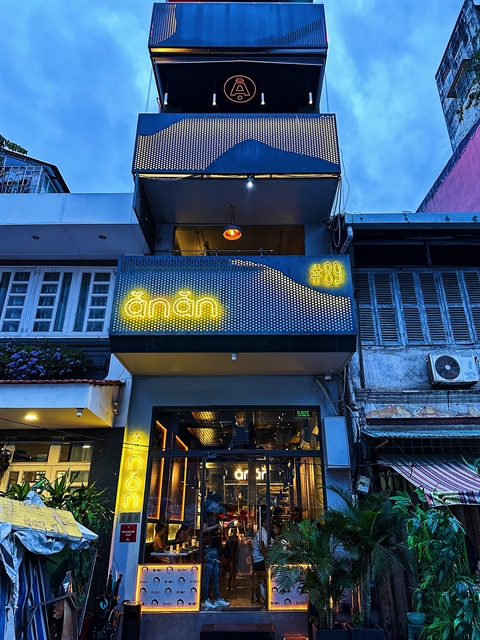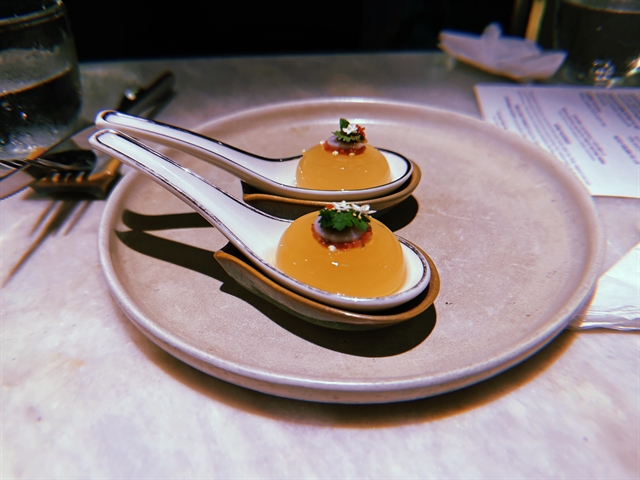 Restaurant Review
Restaurant Review

 |
| The restaurant's floors hide many treasures behind the modern Vietnamese architecture. |
By Alex Reeves
@afreeves23
“Ăn” means to eat, Ănăn is, quite literally, “Eat eat!” A restaurant so good they named it twice? I took this message rather literally and made sure I visited over two evenings for the full experience and a sneak peek into what arguably Việt Nam’s most celebrated eatery has to offer. The first was an opportunity to enjoy the intricately designed 12-course tasting menu and latterly to delve into the more rustic and hearty à la carte menu while exploring the upper floors of the space.
Let me set the scene: It’s Sunday evening and I’m sitting upstairs in Nhậu Nhậu, yep, you guessed it; drink drink, the second of four floors in one of the country’s distinctive tubular houses, it’s a chic modern cocktail bar and the younger sibling of the building's physical and metaphorical foundation, namely, Ănăn, the subject of today’s piece.
As with many tube houses, the slender but typical aspect of this modern take on Vietnamese architecture hides great secrets. From the outside, it’s difficult to envisage what could be hiding inside. The innovative approach that the tube house takes in packaging so much into so little, while remaining visually striking, is the first of many almost irresistible metaphors to be drawn in comparison to the food here at Ănăn.
I’m sitting at the bar with head chef and proprietor Peter Cuong Franklin and his visiting friends Tuan and Linh, reflecting on the food we’ve eaten and playfully engaging in a game centred around guessing the heritage of a fellow diner who’s just joined the conversation. But how did we get here? What does this have to do with the food? Well, let me explain.
Tuan’s heritage spans Việt Nam, the US and South Korea, while his wife Linh, born and raised in Hà Nội, had until recently been living abroad with him in L.A. for some time. Together, they’ve taken the decision to return to Việt Nam for the birth of their first child (and congratulations to them both!). Case, the fellow diner in question, is the subject of the fun; while he studies medicine at UCLA, it turns out that Hong Kong is his ancestral homeland.
 |
| The team work quietly like a well-oiled machine from their open kitchen. |
Chef Peter, who has been leading our humorous interrogation, is himself Vietnamese-American, having left Sài Gòn in April 1975 before reconnecting with his mother in a moment that would change the direction of his whole life and career. From investment banker to chef, he has taken the opportunity to spread his wings and soak up the knowledge and techniques of kitchens across the globe. Le Cordon Bleu? Check. Staging at some of the world's most renowned kitchens from Caprice, Hong Kong to Alinea, Chicago? Check.
Yet it’s here in his homeland of Việt Nam where he founded a restaurant and formed it with an ethos; his own vision of a country embracing its history and looking to push forward and look outwards; to innovate. It isn’t lost on me that our drink of choice in this moment is “Crème de Cacao” a delightful Marou (award-winning Vietnamese chocolatier) chocolate-based liqueur from the Hanoian distillery. "Về để đi" - Peter explains the literal translation of this to us as "returning in order to go".
This theme, or thread that exists between the people present, of having to leave and the need to return (whether they go again or not) is something shared and appreciated by each of us. All of us have spent time away from our home countries or cities and left, returned, and perhaps left again in search of a driving force in our own respective pursuits. The impact of this process is apparent in the details of the dishes we discuss at length.
It feels right, almost serendipitously so, that I was able to enjoy my full dining experience at Ănăn the previous evening: the anniversary of Vietnamese independence. In a sense, Ănăn and the very tasting menu I enjoyed, accompanied with its recent Michelin recognition, is a celebration of the chef’s own culinary independence. Championing Vietnamese produce and adoption of best international practice is truly a part of Ănăn’s DNA.
Michelin stars aren’t ten a penny and it's the combination of innovative techniques and a deep understanding of the country’s bounty - often sourced from local markets - which are being showcased here. Despite the global resume and being named in Asia’s Top 50 Best Restaurants, Peter’s "true culinary inspiration" is his mother's humble yet no less popular noodle shop back in Dalat, a testament to the enduring power of home-cooked meals. His team brings this soul to each and every plate.
Chef Peter's vision, "Cuisine Mới", or New Vietnamese Cuisine, is best expressed through his own curated tasting menu beginning with the Amuse Bouche, here it takes the form of a delicate Oscietra caviar and gold flake soft smoked egg served on a bed of dill. As hot water is added to the bowl, the flavours infuse in a cloud of steam and make for a visually entertaining start to our journey.
To follow is a high-end take on a continental favourite: The humble spring roll is transformed with the addition of pork, foie gras, and black truffle. From the off, it’s apparent that no cost is spared in incorporating the great flavours of fine dining into neat Vietnamese packaging. This is followed by a delightfully creamy “Salmon Bánh Nhúng" (street waffle), which is both colourful and tastes as good as it looks. Peter explains the combination of French and Asian techniques when baking the tart and piping the filling into the firm dough base.
Up next we have "Crab & Uni", where the edible part of a sea urchin is served inside a Cà Mau crab with red pomelo, crispy shallots and prawn head sauce. It’s clean, fresh and flavoursome, a coastal treat to ponder. The surprises while adhering to a Vietnamese-themed consistency keep coming. "Le Petit 'bé' Bánh Mì Sài Gòn" makes its entrance with uni pâté, Wagyu beef, and Oscietra Caviar, all wrapped in an ethereal air baguette. It’s quaint, cute even, and, as with previous dishes, doesn’t disappoint the taste buds as a one-bite meaty little package.
We then journey back to Hà Nội with "Chả Cá Lã Vọng”. This northern staple is transformed with the introduction of buttery black cod in favour of the typical river fish. Dipped in a turmeric and dill cream sauce this may well be my pick of the menu. Before I continue comes a chance to pause and savour the "Sorbet Mekong", a tropical medley of mango, passion fruit, and kaffir lime. It's a palate cleanser; a refreshing moment of calm before we dive into the next chapter.
"Bún Chả Bourdain" kicks off the second half of the menu; a notably named homage and nod of respect from one Chef to another. The late chief culinary storyteller’s relationship with Việt Nam is acknowledged with all the aspects of bún chả: rice vermicelli, grilled pork, and fresh herbs to be enjoyed in one bite, and washed down with a shot of Jasmine IPA (a popular craft beer from Pasteur Street Brewery).
 |
| 'Molecular Phở' - Vietnam’s most iconic dish remastered with a rare technique from Ferran Arria’s El Bulli. |
The one bites also keep coming, with “Molecular Phở”, Việt Nam’s most iconic dish remastered through the techniques of El Bulli’s Ferran Adria, spherifying the Wagyu and black truffle-infused broth in a gelatinous casing displayed on a spoon - a rare opportunity to sample such a technique, and a first time for myself. Thankfully, a second spoon was waiting, in which I gratefully indulged.
The menu continues to impress, bringing "Lamb Rib Giả Cầy”, Australian grain-fed lamb with an ever so slight dose of the infamous mắm tôm (fermented shrimp paste), before Bến Tre young coconut and caviar combine delightfully, and we’re eventually treated to a rich 70 per cent chocolate mochi ball and the classic Dalat petit fours, which we are instructed to eat in the order in which we would draw the number.
The decision to name a dish in honour of Anthony Bourdain reminded me of a chapter in his second book, A Cook’s Tour, in which he defends the right of chefs to not be physically present in the restaurants they’ve built or popularised, and in some cases bare their names. While I may agree, things are different here as Chef Peter greets diners as often as possible with the warmth of the beating Saigon [former name of HCM City] tarmac.
As the last bite is savoured and the final drop of wine disappears from our glasses (trust the chef on this one), I reflect on the poetic symmetry between this extraordinary meal and Independence Day in Việt Nam. On the day Việt Nam asserted its independence and began a new chapter 78 years ago, Ănăn Saigon invites us to witness a new chapter in Vietnamese cuisine.
Việt Nam’s culture and history are as rich as its food, its future as bright as the smile on Chef Peter’s face as he embraces the opportunity to engage with diners, explaining the ingenuity and intention of the culinary journey through Việt Nam upon which they’re embarking.
Enjoying these moments alongside some fantastic socialising across my two evenings has me asking a question: When is a meal more than just a meal? When is a restaurant more than just a restaurant? The answers are simple enough: When it’s an experience. And my time spent at Ănăn most certainly was. VNS
Name: Ănăn Saigon
Address: 89 Tôn Thất Đạm, Bến Nghé, Quận 1, Thành phố Hồ Chí Minh
Price: VNĐ 2.9 million or US$125 (for the Chef’s 12-course tasting menu)
Dining companions: Those on fellow food pilgrimages.
Top tip: Take the chance to enjoy the bar upstairs or the rooftop if seats are available; it adds a different dimension to the visit. Keep your eyes peeled for Pot Au Pho.




